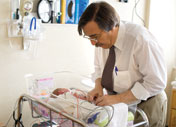Entrepreneurship Grant Funds Noninvasive Baby Reflux Monitor

Dr. Ira Gewolb has used an MIIE grant to develop a less invasive method of detecting reflux in babies.
Acid reflux is a painful nuisance for most who suffer symptoms such as heartburn, but it can also lead to pneumonia and worse for infants. Just detecting it—often by inserting a tube through the nose into the esophagus—can be traumatic.
But Ira Gewolb, chief of the Division of Neonatology in the MSU College of Human Medicine, is testing a far less invasive diagnostic method he developed for babies, supported by a university technology commercialization partnership.
Preemies and their parents are accustomed to invasive procedures, Gewolb said, "but if you try to put a tube down a one-and-a-half year-old's nose for 24 hours, it's not a pretty picture." X-rays often are used instead, he added, but aren't always reliable.
Gewolb and laboratory associate Frank Vice are refining a prototype for a neonatal gastroesophageal reflux monitor based on a common engineering instrument, the accelerometer. Taped to an infant's chest, it picks up low-frequency sound as reflux backs up from the stomach into the esophagus.
"Federal funding of research enables the development of basic science concepts, but there is often a gap in funding as the science becomes more applied or product oriented."
Charles A. Hasemann
More than half of newborns suffer from acid reflux, ranging in severity "from the happy spitters to the scrawny screamers" who resist feeding, Gewolb said, but the vast majority outgrow it after they start to sit up. Ex-preemies are especially susceptible, however, and often go home with medications that themselves have side effects. He hopes the monitor, which is currently being tested at Sparrow Hospital's neonatology unit, ultimately can be approved for use in preemies as well as older infants and even certain adults.
Gewolb is one of seven MSU faculty inventors who won technology transfer grants this year from the Michigan Initiative for Innovation & Entrepreneurship (MIIE) and a predecessor program.
The grants are meant to help bridge the difficult financial chasm separating campus lab developments from their commercialization. MIIE includes Michigan's 15 state universities with funding from the C.S. Mott Foundation, the New Economy Initiative for Southeast Michigan, and the Dow Foundation.
"Federal funding of research enables the development of basic science concepts, but there is often a gap in funding as the science becomes more applied or product oriented," said Charles A. Hasemann, executive director of MSU Business-CONNECT and interim technology transfer office chief. "These grant programs fill that gap and help move the technology from the nascent stage to proof of concept and on to prototype. The grants are invaluable in helping to move MSU's technologies toward commercialization."
Grantees work with the university's technology transfer office, MSU Technologies, to patent and then license their innovations to companies or investors that can bring them to market. The reflux monitor has been under development for about a decade, Gewolb said, resulting from his work applying accelerometers to infant feeding and swallowing problems.